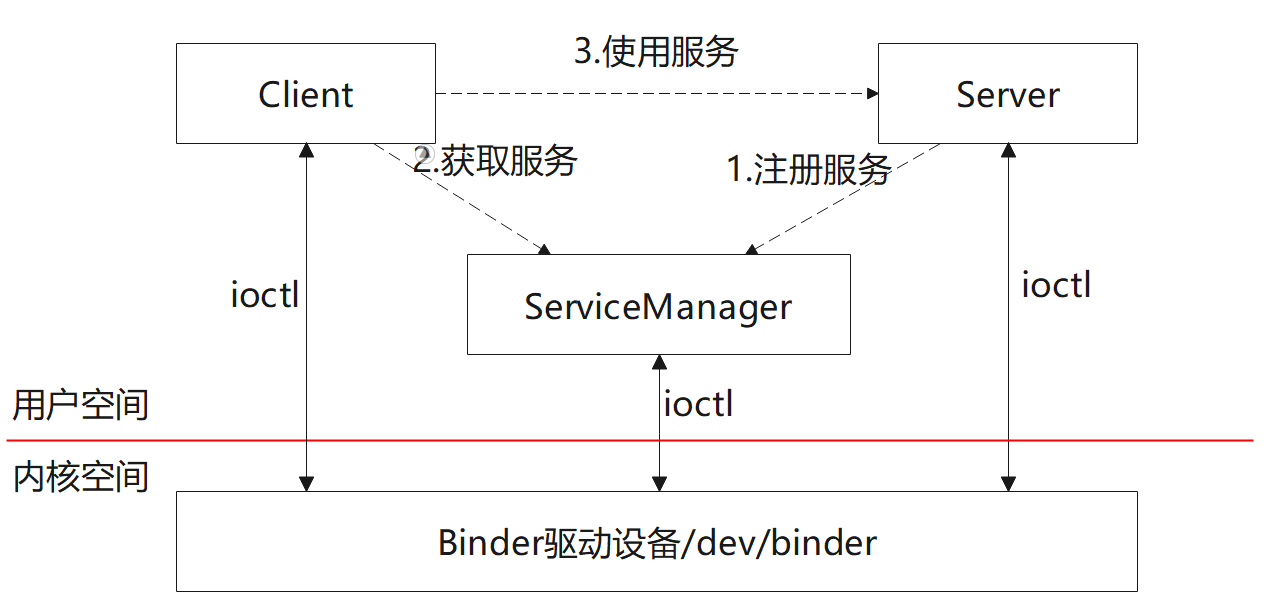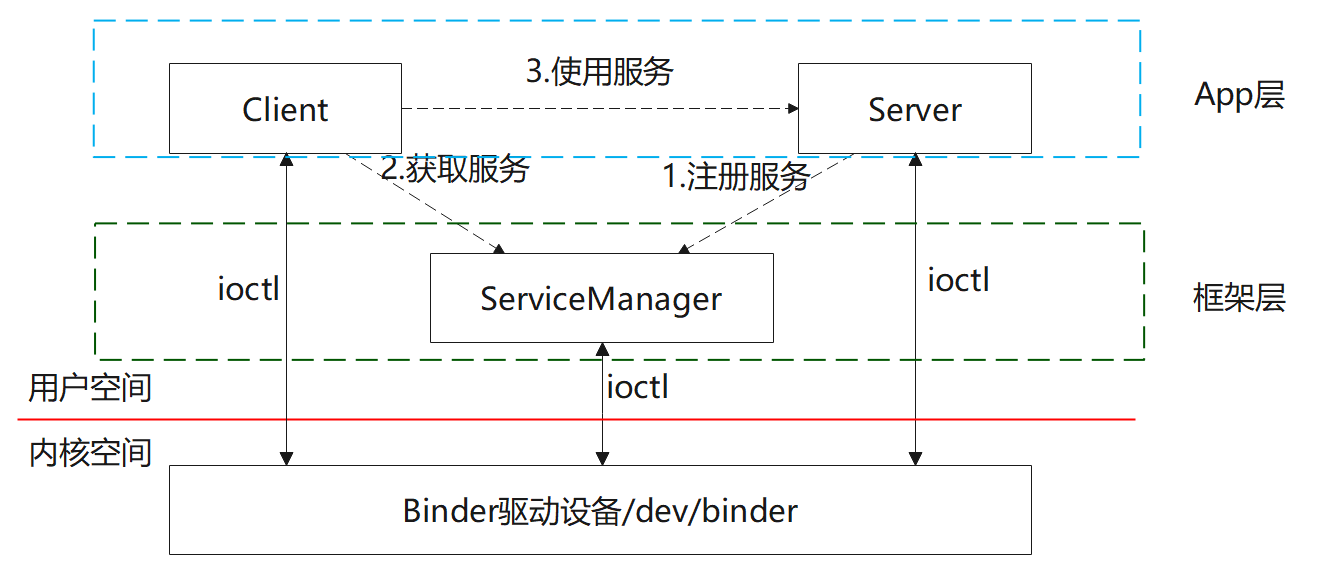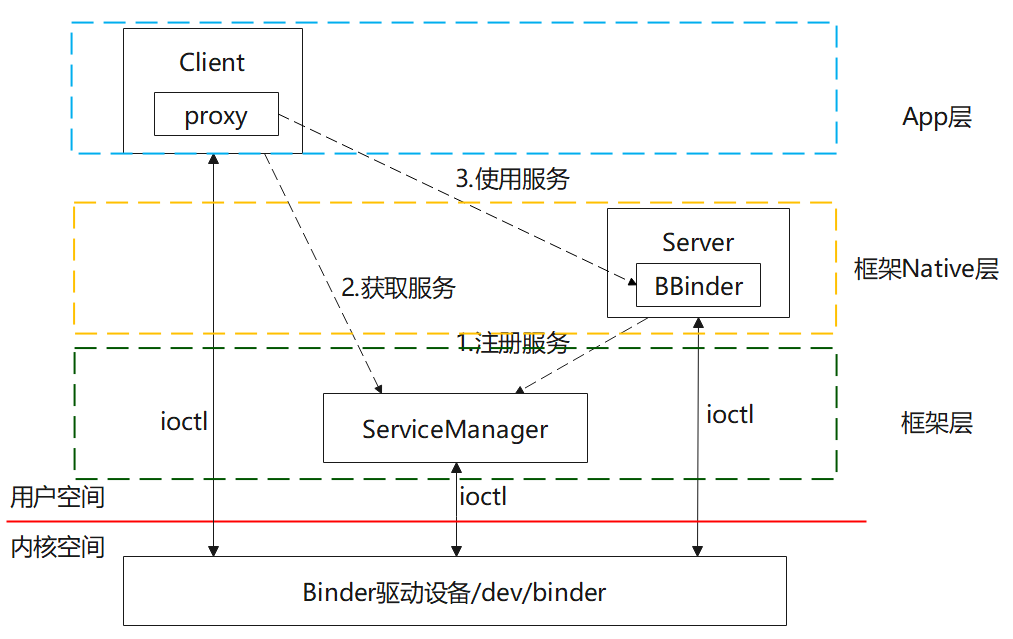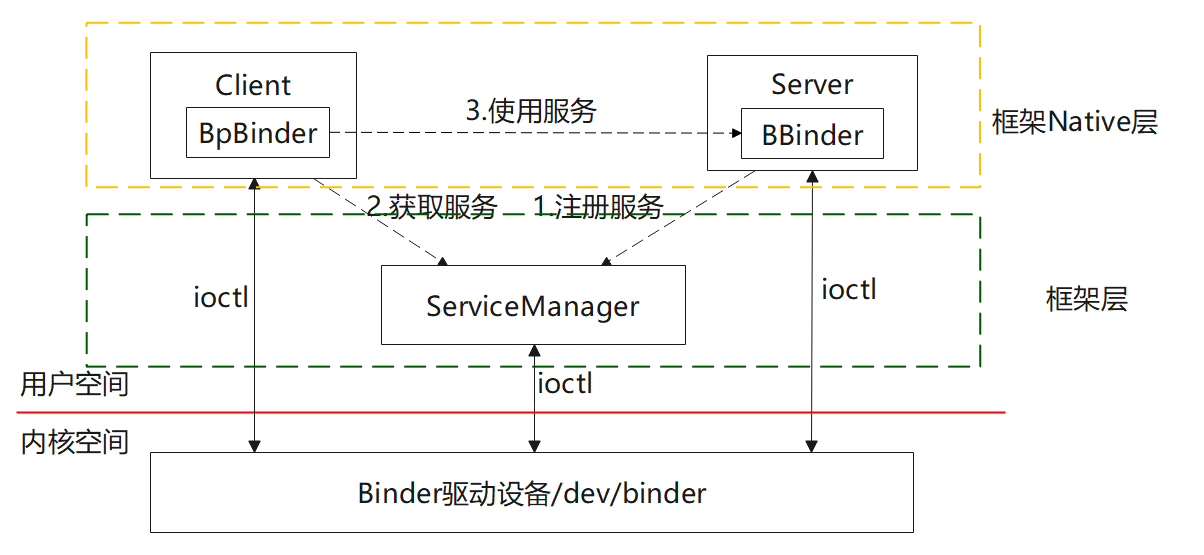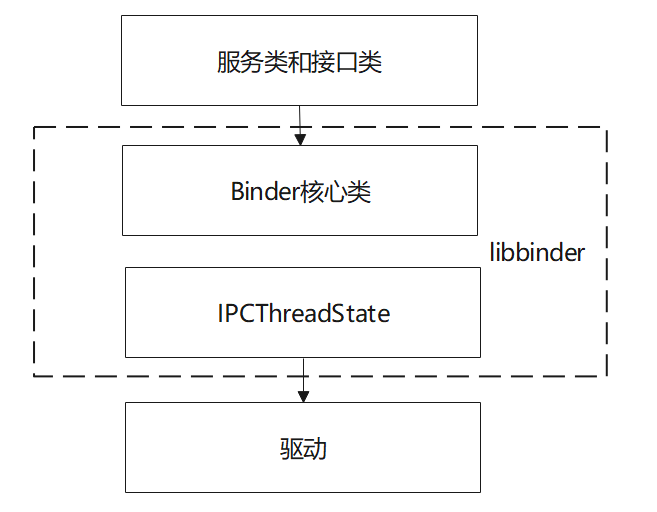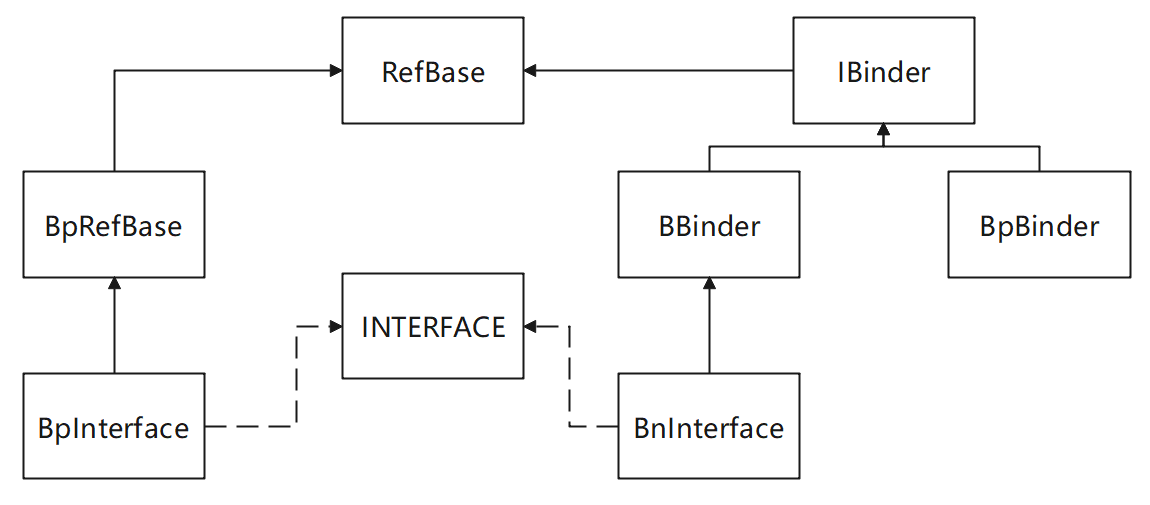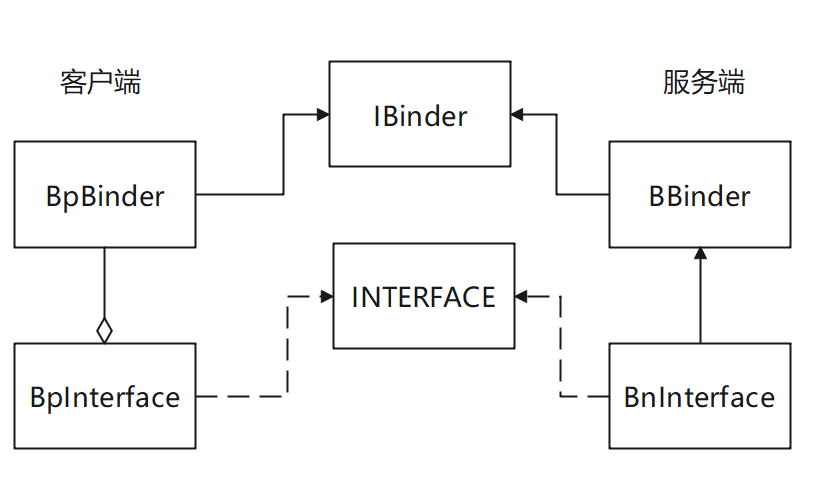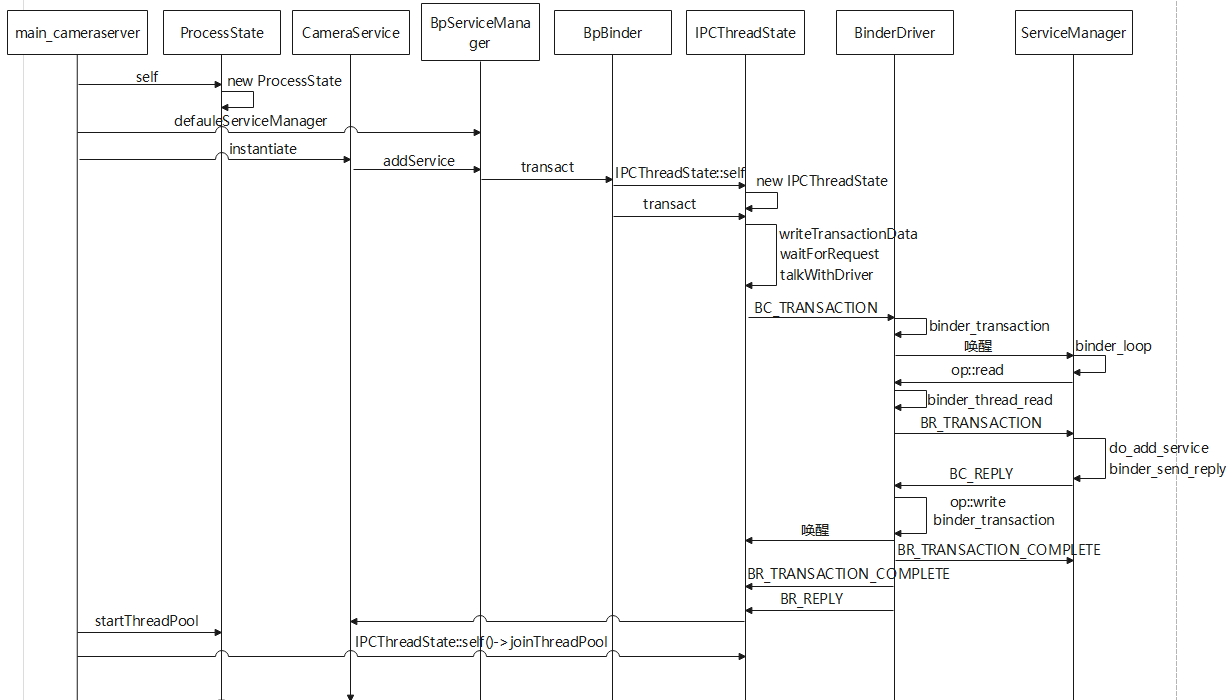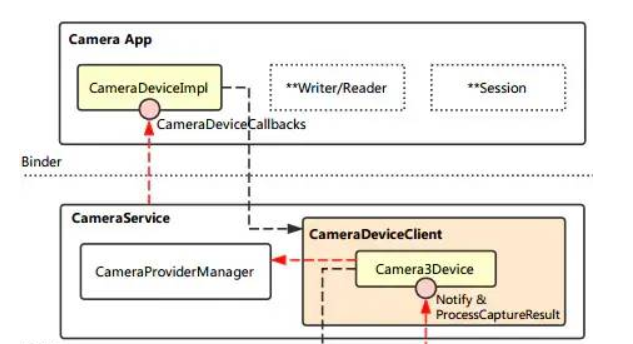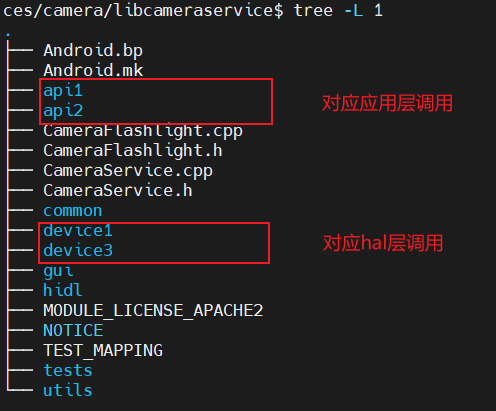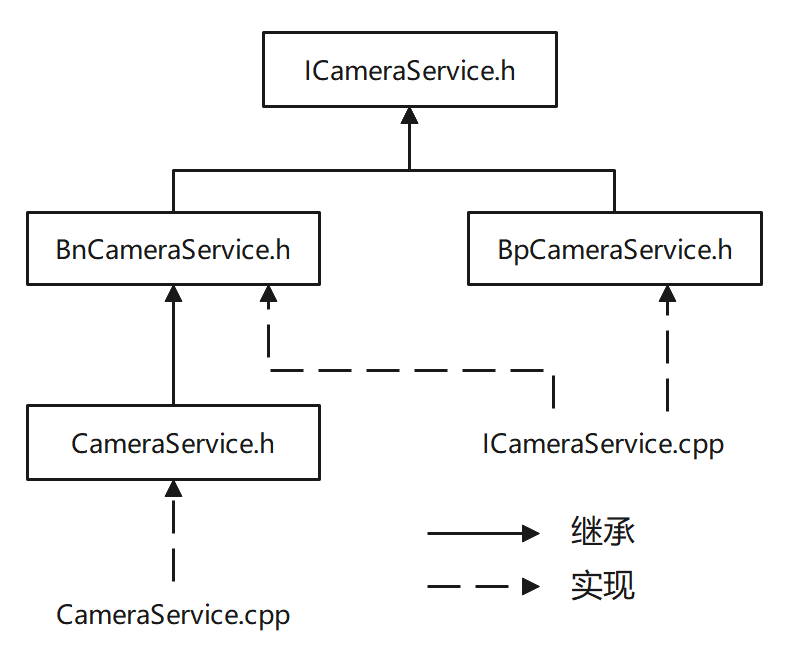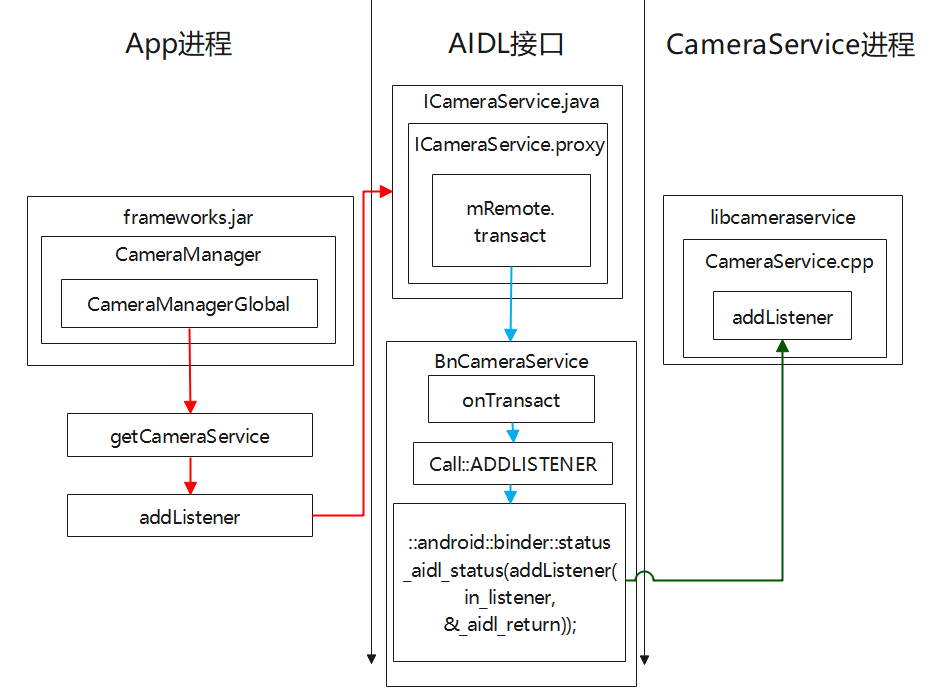AIDL3 JAVA和C++通信
2000 Words|Read in about 10 Min|本文总阅读量次
祝各位女神3.8快乐~最近在阅读Android源码的过程中再次遇到AIDL。和以往不同,这次是Java层和c++层的相互调用,跟以往App端的两个Java进程的IPC通信有区别。
笔者在先前已经简单的分析了AIDL,但是AIDL远不止这么JAVA-JAVA通信这么简单,事实上Android系统中可以通过binder,实现双向IPC通信,可以是JAVA - JAVA 、 JAVA - C++ 、 C++ - C++ ,都可以通过Binder进行IPC双向通信。本文主要通过JAVA-C++的通信更加深入了解AIDL。
1.Binder简介
Binder作为Android系统提供的一种IPC机制,这是Android系统中最重要的组成,也是最难理解的一块知识点,错综复杂。
Binder是Android整个系统的核心,考虑复杂性,暂时对其具体实现过程简单提下,具体需要在Binder篇章深入研究。
由于AIDL可以是C++层也可以是Java层,那么上述Binder通信的变体就会出现下面这几种。
1)两个App进程通信
2)一个App进程,一个Native进程通信
3)两个Native进程通信
结合代表性,本文主要对第二种情况的通信展开描述。
2.Binder核心类介绍和原理
2.1Binder框架
2.1.1Binder由四部分组成
Binder驱动:Binder的核心,实现底层操作
ServiceManager:守护进程,Binder服务的管理者
服务端:Binder的提供者Bn
客户端:Binder的使用者Bp
2.1.2Binder设计分层
Binder实现通过libbinder库实现。Binder源码点击这里。
/frameworks/native/libs/binder
| /frameworks/native/libs/binder |
|---|
| /frameworks/native/libs/binder/Binder.cpp |
| /frameworks/native/libs/binder/BpBinder.cpp |
| /frameworks/native/libs/binder/IInterface.cpp |
| /frameworks/native/libs/binder/IPCThreadState.cpp |
| /frameworks/native/libs/binder/ProcessState.cpp |
| /frameworks/native/libs/binder/Parcel.cpp |
| /frameworks/native/libs/binder/include/binder/Binder.h |
| /frameworks/native/libs/binder/include/binder/BpBinder.h |
| /frameworks/native/libs/binder/include/binder/IBinder.h |
| /frameworks/native/libs/binder/include/binder/IInterface.h |
| /frameworks/native/libs/binder/include/binder/IPCThreadState.h |
| /frameworks/native/libs/binder/include/binder/ProcessState.h |
| /frameworks/native/libs/binder/include/binder/Parcel.h |
2.2Binder核心类
IIterface类,BpInterface类,BnInterface类,BBinder类,BpBinder类,IBinder类
2.2.1各类之间的继承
各类的继承关系
简化成客户端和服务端的关系
2.2.2服务端
以下为Android11源码分析
BnInterface类,开发Binder服务必须要继承的类
1//frameworks/native/libs/binder/include/binder/IInterface.h#BnInterface
2template<typename INTERFACE>
3class BnInterface : public INTERFACE, public BBinder
4{
5public:
6 virtual sp<IInterface> queryLocalInterface(const String16& _descriptor);
7 virtual const String16& getInterfaceDescriptor() const;
8
9protected:
10 typedef INTERFACE BaseInterface;
11 virtual IBinder* onAsBinder();
12};
BBinder类,服务类的核心。这里的IBinder类前面的clang::lto_visibility_public详见这里。
1//frameworks/native/libs/binder/include/binder/IBinder.h#transact
2class [[clang::lto_visibility_public]] IBinder : public virtual RefBase{
3 virtual status_t transact( uint32_t code,
4 const Parcel& data,
5 Parcel* reply,
6 uint32_t flags = 0) = 0;
7};
最终实现是在Binder
1//frameworks/native/libs/binder/Binder.cpp#transact
2status_t BBinder::transact(
3 uint32_t code, const Parcel& data, Parcel* reply, uint32_t flags)
4{
5 data.setDataPosition(0);
6
7 status_t err = NO_ERROR;
8 switch (code) {
9 case PING_TRANSACTION:
10 err = pingBinder();
11 break;
12 case EXTENSION_TRANSACTION:
13 err = reply->writeStrongBinder(getExtension());
14 break;
15 case DEBUG_PID_TRANSACTION:
16 err = reply->writeInt32(getDebugPid());
17 break;
18 default:
19 err = onTransact(code, data, reply, flags);
20 break;
21 }
22
23 // In case this is being transacted on in the same process.
24 if (reply != nullptr) {
25 reply->setDataPosition(0);
26 }
27
28 return err;
29}
其中BBinder负责和更底层的IPCThread交互,IPCThread会调用BBinder的transact方法,transact方法会调用到继承类中的onTransact方法实现交互。
因此,我们自己只需要对对BBinder的继承类重写onTransact方法,既可以实现数据与驱动交互。
1//frameworks/native/libs/binder/Binder.cpp#onTransact
2status_t BBinder::onTransact(
3 uint32_t code, const Parcel& data, Parcel* reply, uint32_t /*flags*/)
4{
5 switch (code) {
6 case INTERFACE_TRANSACTION:
7 reply->writeString16(getInterfaceDescriptor());
8 return NO_ERROR;
9
10 case DUMP_TRANSACTION: {
11 int fd = data.readFileDescriptor();
12 int argc = data.readInt32();
13 Vector<String16> args;
14 for (int i = 0; i < argc && data.dataAvail() > 0; i++) {
15 args.add(data.readString16());
16 }
17 return dump(fd, args);
18 }
19
20 case SHELL_COMMAND_TRANSACTION: {
21 int in = data.readFileDescriptor();
22 int out = data.readFileDescriptor();
23 int err = data.readFileDescriptor();
24 int argc = data.readInt32();
25 Vector<String16> args;
26 for (int i = 0; i < argc && data.dataAvail() > 0; i++) {
27 args.add(data.readString16());
28 }
29 sp<IShellCallback> shellCallback = IShellCallback::asInterface(
30 data.readStrongBinder());
31 sp<IResultReceiver> resultReceiver = IResultReceiver::asInterface(
32 data.readStrongBinder());
33
34 // XXX can't add virtuals until binaries are updated.
35 //return shellCommand(in, out, err, args, resultReceiver);
36 (void)in;
37 (void)out;
38 (void)err;
39
40 if (resultReceiver != nullptr) {
41 resultReceiver->send(INVALID_OPERATION);
42 }
43
44 return NO_ERROR;
45 }
46
47 case SYSPROPS_TRANSACTION: {
48 report_sysprop_change();
49 return NO_ERROR;
50 }
51
52 default:
53 return UNKNOWN_TRANSACTION;
54 }
55}
2.2.3客户端
BpBinder
这个是客户端的核心
1//frameworks/native/libs/binder/include/binder/IInterface.h#BpInterface
2template<typename INTERFACE>
3class BpInterface : public INTERFACE, public BpRefBase
4{
5public:
6 explicit BpInterface(const sp<IBinder>& remote);
7
8protected:
9 typedef INTERFACE BaseInterface;
10 virtual IBinder* onAsBinder();
11};
与BnBinder中BnInterface类继承BBinder不同的是,BpInterface类不是继承BpBinder的,而是继承BpRefBase类的。这个可以更加灵活地进行应用开发,BpBinder更改对客户端实现无影响。
1//frameworks/native/libs/binder/include/binder/Binder.h#BpRefBase
2class BpRefBase : public virtual RefBase
3{
4protected:
5 explicit BpRefBase(const sp<IBinder>& o);
6 virtual ~BpRefBase();
7 virtual void onFirstRef();
8 virtual void onLastStrongRef(const void* id);
9 virtual bool onIncStrongAttempted(uint32_t flags, const void* id);
10
11 inline IBinder* remote() { return mRemote; }
12 inline IBinder* remote() const { return mRemote; }
13
14private:
15 BpRefBase(const BpRefBase& o);
16 BpRefBase& operator=(const BpRefBase& o);
17
18 IBinder* const mRemote;
19 RefBase::weakref_type* mRefs;
20 std::atomic<int32_t> mState;
21};
BpBinder
负责与底层IPCThread交互,代理类中的函数实现会最终调用IBinder的transact,transact调用IPCThread函数向驱动传递数据。
1//frameworks/native/libs/binder/include/binder/BpBinder.h#transact
2class BpBinder : public IBinder{
3 virtual status_t transact( uint32_t code,
4 const Parcel& data,
5 Parcel* reply,
6 uint32_t flags = 0) final;
7};
最终实现在BpBinder.cpp
1//frameworks/native/libs/binder/BpBinder.cpp#transact
2status_t BpBinder::transact(
3 uint32_t code, const Parcel& data, Parcel* reply, uint32_t flags)
4{
5 // Once a binder has died, it will never come back to life.
6 if (mAlive) {
7 ...
8 status_t status = IPCThreadState::self()->transact(
9 mHandle, code, data, reply, flags);
10 if (status == DEAD_OBJECT) mAlive = 0;
11
12 return status;
13 }
14
15 return DEAD_OBJECT;
16}
Binder代理类
asInterface,实际上这个是宏定义出来的
1//frameworks/native/libs/binder/include/binder/IInterface.h#DECLARE_META_INTERFACE
2#define DECLARE_META_INTERFACE(INTERFACE) \
3public: \
4 static const ::android::String16 descriptor; \
5 static ::android::sp<I##INTERFACE> asInterface( \
6 const ::android::sp<::android::IBinder>& obj); \
7 virtual const ::android::String16& getInterfaceDescriptor() const; \
8 I##INTERFACE(); \
9 virtual ~I##INTERFACE(); \
10 static bool setDefaultImpl(std::unique_ptr<I##INTERFACE> impl); \
11 static const std::unique_ptr<I##INTERFACE>& getDefaultImpl(); \
12private: \
13 static std::unique_ptr<I##INTERFACE> default_impl; \
14public: \
具体实现
1//frameworks/native/libs/binder/include/binder/IInterface.h#DO_NOT_DIRECTLY_USE_ME_IMPLEMENT_META_INTERFACE
2#define DO_NOT_DIRECTLY_USE_ME_IMPLEMENT_META_INTERFACE(INTERFACE, NAME)\
3 ...
4 ::android::sp<I##INTERFACE> I##INTERFACE::asInterface( \
5 const ::android::sp<::android::IBinder>& obj) \
6 { \
7 ::android::sp<I##INTERFACE> intr; \
8 if (obj != nullptr) { \
9 intr = static_cast<I##INTERFACE*>( \
10 obj->queryLocalInterface( \
11 I##INTERFACE::descriptor).get()); \
12 if (intr == nullptr) { \
13 intr = new Bp##INTERFACE(obj); \
14 } \
15 } \
16 return intr; \
17 } \
考虑到上述queryLocalInterface的入参,可以是BBinder,也可以是BpBinder,那么BnInterface中的实现,返回的是BnInterface实例它本身。
1//frameworks/native/libs/binder/include/binder/IInterface.h#BnInterface<INTERFACE>::queryLocalInterface
2template<typename INTERFACE>
3inline sp<IInterface> BnInterface<INTERFACE>::queryLocalInterface(
4 const String16& _descriptor)
5{
6 if (_descriptor == INTERFACE::descriptor) return this;
7 return nullptr;
8}
BpInterface的本身没有queryLocalInterface方法,它的构造BpInterface(const sp& remote);中的参数是IBinder类型,最终调用到的是IBinder中的queryLocalInterface方法。也就是BpInterface间接调用BpBinder,BpBinder的实现是返回nullptr,那么一定会调用new Bp##INTERFACE(obj);这里。客户端才能生成真正的代理类,服务端生成不了。
1//frameworks/native/libs/binder/Binder.cpp#IBinder::queryLocalInterface
2sp<IInterface> IBinder::queryLocalInterface(const String16& /*descriptor*/)
3{
4 return nullptr;
5}
2.2.4总结
BBinder是服务端的核心,BpBinder是客户端的核心,两者都是IBinder派生出来的,其中服务端需要实现BnInterface,客户端需要实现BpInterface。
2.3Binder死亡通知
检测一个服务,是不是宕机或者已经挂死,可以通过死亡通知来检测。
2.3.1linkToDeath
IBinder提供了一个死亡通知接口linkToDeath。
其有三个参数,recipient为接收对象,必须自定义实现。
1//frameworks/native/libs/binder/include/binder/IBinder.h#linkToDeath
2class [[clang::lto_visibility_public]] IBinder : public virtual RefBase{
3 virtual status_t linkToDeath(const sp<DeathRecipient>& recipient,
4 void* cookie = nullptr,
5 uint32_t flags = 0) = 0;
6};
这个类DeathRecipient就是接口,用于回调,需要重载binderDied
1//frameworks/native/libs/binder/include/binder/IBinder.h#DeathRecipient
2class DeathRecipient : public virtual RefBase
3{
4 public:
5 virtual void binderDied(const wp<IBinder>& who) = 0;
6};
考虑到IBinder,既可以是BBinder,也可以是BpBinder。他们又有分别的实现。
BBinder
1//frameworks/native/libs/binder/Binder.cpp#linkToDeath
2status_t BBinder::linkToDeath(
3 const sp<DeathRecipient>& /*recipient*/, void* /*cookie*/,
4 uint32_t /*flags*/)
5{
6 return INVALID_OPERATION;
7}
BpBinder
1//frameworks/native/libs/binder/BpBinder.cpp#linkToDeath
2status_t BpBinder::linkToDeath(
3 const sp<DeathRecipient>& recipient, void* cookie, uint32_t flags)
4{
5 Obituary ob;
6 ob.recipient = recipient;
7 ob.cookie = cookie;
8 ob.flags = flags;
9
10 LOG_ALWAYS_FATAL_IF(recipient == nullptr,
11 "linkToDeath(): recipient must be non-NULL");
12
13 {
14 AutoMutex _l(mLock);
15
16 if (!mObitsSent) {
17 if (!mObituaries) {
18 mObituaries = new Vector<Obituary>;
19 if (!mObituaries) {
20 return NO_MEMORY;
21 }
22 ALOGV("Requesting death notification: %p handle %d\n", this, mHandle);
23 getWeakRefs()->incWeak(this);
24 IPCThreadState* self = IPCThreadState::self();
25 self->requestDeathNotification(mHandle, this);
26 self->flushCommands();
27 }
28 ssize_t res = mObituaries->add(ob);
29 return res >= (ssize_t)NO_ERROR ? (status_t)NO_ERROR : res;
30 }
31 }
32
33 return DEAD_OBJECT;
34}
因此,只能在客户端接收死亡通知。
executeCommand
那么有了死亡通知的接口,那么谁来发送死亡通知呢?
这个死亡通知实际上是由驱动推送的,驱动检测某个服务死亡,会根据设置向应用推送消息。
1//frameworks/native/libs/binder/IPCThreadState.cpp#executeCommand
2status_t IPCThreadState::executeCommand(int32_t cmd)
3{
4 BBinder* obj;
5 RefBase::weakref_type* refs;
6 status_t result = NO_ERROR;
7
8 switch ((uint32_t)cmd) {
9 ...
10 case BR_DEAD_BINDER:
11 {
12 BpBinder *proxy = (BpBinder*)mIn.readPointer();
13 proxy->sendObituary();
14 mOut.writeInt32(BC_DEAD_BINDER_DONE);
15 mOut.writePointer((uintptr_t)proxy);
16 } break;
17 ...
18 default:
19 ALOGE("*** BAD COMMAND %d received from Binder driver\n", cmd);
20 result = UNKNOWN_ERROR;
21 break;
22 }
23
24 if (result != NO_ERROR) {
25 mLastError = result;
26 }
27
28 return result;
29}
调用到BpBinder中的sendObituary方法
1//frameworks/native/libs/binder/BpBinder.cpp#sendObituary
2void BpBinder::sendObituary()
3{
4 ...
5 if (obits != nullptr) {
6 const size_t N = obits->size();
7 for (size_t i=0; i<N; i++) {
8 reportOneDeath(obits->itemAt(i));
9 }
10
11 delete obits;
12 }
13}
而reportOneDeath最终会调用到上述死亡通知篇章中的回调函数binderDied,这也是为什么该函数必须重载。
1//frameworks/native/libs/binder/BpBinder.cpp#reportOneDeath
2void BpBinder::reportOneDeath(const Obituary& obit)
3{
4 sp<DeathRecipient> recipient = obit.recipient.promote();
5 ALOGV("Reporting death to recipient: %p\n", recipient.get());
6 if (recipient == nullptr) return;
7
8 recipient->binderDied(this);
9}
3.AIDL实战
1.接口扩展
1//ITestService.h
2#include <IInterface.h>
3#define TEST_GET 1
4#define TEST_SET 2
5
6namespace android{
7Class ITestService : public IInterface{
8public:
9 DECLARE_META_INTERFACE(TestService);
10 virtual int get() = 0;
11 virtual void set(int value) = 0;
12};
13}
2.服务端
1//BnTestService.h
2namespace android{
3class BnTestService : public BnInterface<ITestService>{
4public:
5 BnTestService();
6public:
7 int cnt = 0;
8 virtual int get();
9 virtual void set(int value);
10 virtual status_t onTransact(uint32_t code,
11 const Parcel& data,
12 Parcel* reply,
13 uint32_t flags = 0);
14};
15}
3.客户端
1#BpTestService.h
2namespace android{
3class BpTestService : public BpInterface<ITestService>{
4public:
5 BpTestService::BpTestService(const sp<IBinder>& impl) : BpInterface<ITestService>(impl);
6public:
7 virtual int get();
8 virtual void set(int value);
9};
10}
3.Bn端的代码实现
1//BnTestService.cpp
2#include "BnTestService.h"
3BnTestService::BnTestService()
4{
5}
6
7status_t BnTestService::onTransact(uint32_t code,
8 const Parcel& data,
9 Parcel* reply,
10 uint32_t flags = 0)
11{
12 switch() {
13 case TEST_GET: {
14 //数据有效性检测
15 CHECK_INTERFACE(ITestService, data, reply);
16 set(data->readInt());
17 return NO_ERROR;
18 } break;
19 case TEST_SET: {
20 //数据有效性检测
21 CHECK_INTERFACE(ITestService, data, reply);
22 reply->writeInt(get());
23 return NO_ERROR;
24 } break;
25 default:
26 return IBinder::onTransact(code, data, reply, flag);
27 }
28}
29
30int BnTestService::get()
31{
32 return cnt;
33}
34
35void BnTestService::set(int cnt)
36{
37 this->cnt = cnt;
38}
4.Bp端的代码实现
1namespace android{
2IMPLEMENT_META_INTERFACE(ITestService, "android.test.ITestService");
3
4BpTestService::BpTestService(const sp<IBinder>& impl) : BpInterface<ITestService>(impl)
5{
6}
7
8int BpTestService::get()
9{
10 Parcel data, reply;
11 remote()->transact(TEST_GET, data, &reply);
12 return reply.readInt();
13}
14
15void BpTestService::set(int cnt)
16{
17 Parcel data, reply;
18 data.writeInt(cnt);
19 remote()->transact(TEST_SET, data, &reply);
20}
21}
Bp中的remote(),就是mRemote,而mRemote是在Bp构造的时候传入的impl,即为BpBinder的一个实例。
1//frameworks/native/libs/binder/include/binder/Binder.h#BpRefBase::remote
2inline IBinder* remote() { return mRemote; }
4.系统源码实例分析
事实上,源码中有大量的使用这类AIDL的方式。
举一个比较常见的代码,Camera源码中Camera App调用到CameraService里面的功能,这个时候用得就是AIDL。
4.1 addListener
这里调用了cameraService中的addListener方法,但实际上最终实现是在CameraService.cpp中的addListener函数。
1//base/core/java/android/hardware/camera2/CameraManager.java#connectCameraServiceLocked
2private void connectCameraServiceLocked() {
3 if (mCameraService != null || sCameraServiceDisabled) return;
4 Log.i(TAG, "Connecting to camera service");
5
6 IBinder cameraServiceBinder = ServiceManager.getService(CAMERA_SERVICE_BINDER_NAME);
7 ICameraService cameraService = ICameraService.Stub.asInterface(cameraServiceBinder);
8 ...
9 try {
10 CameraStatus[] cameraStatuses = cameraService.addListener(this);
11 for (CameraStatus c : cameraStatuses) {
12 onStatusChangedLocked(c.status, c.cameraId);
13
14 if (c.unavailablePhysicalCameras != null) {
15 for (String unavailPhysicalCamera : c.unavailablePhysicalCameras) {
16 onPhysicalCameraStatusChangedLocked(
17 ICameraServiceListener.STATUS_NOT_PRESENT,
18 c.cameraId, unavailPhysicalCamera);
19 }
20 }
21 }
22 mCameraService = cameraService;
23 }
24 ...
25}
4.2 系统AIDL组成结构
4.2.1 AIDL定义
1//frameworks/av/camera/aidl/android/hardware/ICameraService.aidl
2interface ICameraService {
3 /**
4 * Add listener for changes to camera device and flashlight state.
5 *
6 * Also returns the set of currently-known camera IDs and state of each device.
7 * Adding a listener will trigger the torch status listener to fire for all
8 * devices that have a flash unit.
9 */
10 CameraStatus[] addListener(ICameraServiceListener listener);
11 ...
12}
4.2.2 生成的AIDL的java接口
这部分需要编译frameworks之后才能在/out目录下生成对应的java文件。这个java文件跟在as定义之后生成的java文件类似。
1///out/target/common/obj/JAVA_LIBRARIES/framework_intermediates/dotdot/av/camera.aidl/amdroid/hardware/ICameraService.java#ICmaeraService
2public interface ICmaeraService extends android.os.IInterface
3{
4 ...
5 private static class Proxy implements android.hardware.ICameraService
6 {
7 private android.os.IBinder mRemote;
8 Proxy(android.os.IBinder remote)
9 {
10 mRemote = remote;
11 }
12
13 @override
14 public android.hardware.CameraStatus[] addListener(android.hardware.ICameraServiceListener listener)
15 throws android.os.RemoteException
16 {
17 android.os.Parcel _data = android.os.Parcel.obtain();
18 android.os.Parcel _reply = android.os.Parcel.obtain();
19 android.hardware.CameraStatus[] _result;
20 try
21 {
22 _data.writeInterfaceToken(DESCRIPTOR);
23 _data.writeStrongBinder((((listener != null)) ? (listener.asBinder()) : (null)));
24 mRemote.transact(Stub.TRANSACTION_addListener, _data, _reply, 0);
25 _reply.readException();
26 _result = _reply.createTypedArray(android.hardware.CameraStatus.CREATOR);
27 }
28 finally
29 {
30 _reply.recycle();
31 _data.recycle();
32 }
33 return _result;
34 }
35 }
36 ...
37}
4.2.3 生成的AIDL的c++接口
这里的接口主要有三个,分别是Bp,Bn和I(BpCameraService.h,BnCameraService.h,ICameraService.h)。
这里有两种对应的路径,分别对应32位(android_arm_armv7-a)和64位(android_arm64_armv8-a),笔者这里以64位举例说明。
ICameraService.h
1///out/soong/.intermediates/frameworks/av/camera/libcamera_client/android_arm64_armv8_xxx/gen/aidl/android/hardware/ICameraService.h
2Class ICameraService : public ::android::IInterface
3{
4public:
5 DECLARE_META_INTERFACE(CameraService);
6 virtual ::android::binder::Status addListener(const ::android::sp<::android::hardware::ICameraServiceListener>& listener, ::std::vector<::android::hardware::CameraStatus>* _aidl_return) = 0;
7 enum Call{
8 ADDLISTENER = ::android::IBinder::FIRST_CALL_TRANSACTION + 5;
9 };
10 ...
11};
BpCameraService.h
1///out/soong/.intermediates/frameworks/av/camera/libcamera_client/android_arm64_armv8_xxx/gen/aidl/android/hardware/BpCameraService.h
2class BpCameraService : public ::android::BnInterface<ICameraService>
3{
4public:
5 explicit BpCameraService(const ::android::sp<::android::IBinder>& _aidl_impl;
6 virtual ~BpCameraService() = default;
7 ::android::binder::Status addListener(const ::android::sp<::android::hardware::ICameraServiceListener>& listener, ::std::vector<::android::hardware::CameraStatus>* _aidl_return) override;
8 ...
9};
BnCameraService.h
1///out/soong/.intermediates/frameworks/av/camera/libcamera_client/android_arm64_armv8_xxx/gen/aidl/android/hardware/BnCameraService.h
2class BnCameraService : public ::android::BnInterface<ICameraService>
3{
4public:
5 ::android::status_t BnCameraService::onTransact(uint32_t _aidl_code,
6 const ::android::Parcel& _aidl_data,
7 ::android::Parcel* _aidl_reply,
8 uint32_t _aidl_flags = 0) override;
9};
4.2.4生成的AIDL的c++实现
1///out/soong/.intermediates/frameworks/av/camera/libcamera_client/android_arm64_armv8_xxx/gen/aidl/frameworks/av/camera/aidl/android/hardware/ICameraService.cpp
2::android::status_t BnCameraService::onTransact(uint32_t _aidl_code,
3 const ::android::Parcel& _aidl_data,
4 ::android::Parcel* _aidl_reply,
5 uint32_t _aidl_flags){
6 ::android::status_t _aidl_ret_status = ::android::OK;
7 switch (_aidl_code){
8 case Call::ADDLISTENER:
9 {
10 ::android::sp<::android::hardware::ICameraServiceListener> in_listener;
11 ::std::vector<::android::hardware::CameraStatus> _aidl_return;
12 if (!(_aidl_data.checkInterface(this))){
13 _aidl_ret_status = ::android::BAD_TYPE;
14 break;
15 }
16 _aidl_ret_status = _aidl_data.readStrongBinder(&in_listener);
17 if (((_aidl_ret_status) != (::android::OK))){
18 break;
19 }
20
21 ::android::Binder::Status _aidl_status(addListener(in_listener, &_aidl_return));
22 _aidl_ret_status = _aidl_status.writeToParcel(_aidl_reply);
23
24 if (((_aidl_ret_status) != (::android::OK))){
25 break;
26 }
27 if (!_aidl_status.isOk()){
28 break;
29 }
30 _aidl_ret_status = _aidl_reply->writeParcelableVector(_aidl_return
31 );
32 if (((_aidl_ret_status) != (::android::OK))){
33 break;
34 }
35 }break;
36 }
37}
4.2.5最终的服务实现
最终会调用到cpp继承的库libcameraservice,这里的libcameraservice中有很多目录。这里面会分别对应api接口和device接口,而调用这些借口的正是CameraService,所以我们这个libcameraservice这个库可以看做成由CameraService作为外观者模式,其余函数用于真正实现的库。
1//frameworks/av/services/camera/libcameraservice/CameraService.h
2class CameraService :
3 public BinderService<CameraService>,
4 public virtual ::android::hardware::BnCameraService,
5 public virtual IBinder::DeathRecipient,
6 public virtual CameraProviderManager::StatusListener
7 {
8 virtual binder::Status addListener(const sp<hardware::ICameraServiceListener>& listener,
9 /*out*/
10 std::vector<hardware::CameraStatus>* cameraStatuses);
11 ...
12};
最终实现是在这里CameraService.cpp,具体里面的实现内容就不展开描述,主要是梳理aidl的流程。
1//frameworks/av/services/camera/libcameraservice/CameraService.cpp
2Status CameraService::addListener(const sp<ICameraServiceListener>& listener,
3 /*out*/
4 std::vector<hardware::CameraStatus> *cameraStatuses) {
5 return addListenerHelper(listener, cameraStatuses);
6}
4.3总结
系统源码Camrea Frameworks中的框架的调用,是从上层的app应用调用到sdk jar包中,这个jar包调用到CameraManager,而CameraManager内部去通过aidl方式获取CameraService的实例,并通过这个实例调用addListener方法,最终这个方法调用到libcameraservice中的CameraService.cpp。
除此之外,更加细节的调用如下图所示。
参考
[1] gcwl2016, Android系统中通过binder(AIDL)进行跨层IPC通信, 2019.
[2] i加加, (五十七)Android O WiFi的扫描流程梳理续——梳理java与c++之间的aidl-cpp通信, 2018.
[3] 飞同小可,android系统开发binder调用(C++和java相互调用), 2018.
[4] aaajj, c++层使用和编译aidl文件例子, 2019.
[5] SherlockCharlie, Android8.0 Binder之面向系统服务(二), 2018.
[6] 躬行之, Android进阶之AIDL的使用详解, 2018.
[8] rockmanlc, IBinder类前面的clang::lto_visibility_public, 2021.
[9] syfchao, Android基础框架Binder应用开发(一)-BnBp服务实现, 2021.

